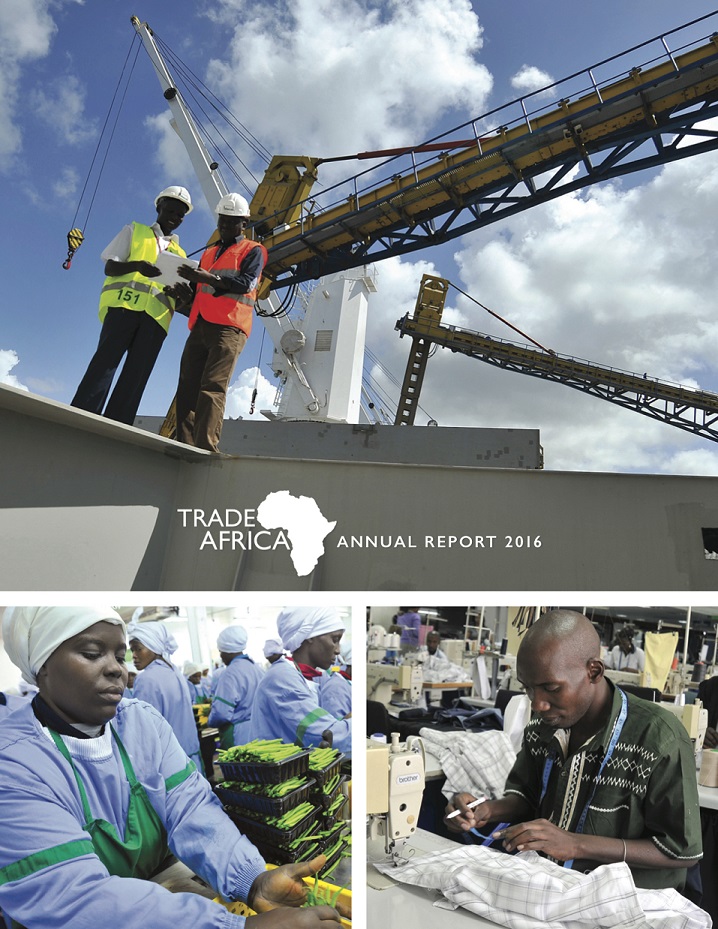- Where We Work
- Interactive Map
- Afghanistan and Pakistan
- Africa
- African Union
- Power Africa
- Trade and Investment Engagement
- Angola
- Benin
- Botswana
- Burkina Faso
- Burundi
- Cameroon
- Central Africa Regional
- Central African Republic
- Chad
- Côte d'Ivoire
- Democratic Republic of the Congo
- Djibouti
- East Africa Regional
- Ethiopia
- Ghana
- Guinea
- Kenya
- Lesotho
- Liberia
- Madagascar
- Malawi
- Mali
- Mauritania
- Mozambique
- Namibia
- Niger
- Nigeria
- Republic of the Congo
- Rwanda
- Sahel Regional
- Senegal
- Sierra Leone
- Somalia
- South Africa
- South Sudan
- Southern Africa Regional
- Sudan
- Swaziland
- Tanzania
- Uganda
- West Africa Regional
- Zambia
- Zimbabwe
- Asia
- Europe and Eurasia
- Latin America and the Caribbean
- Middle East
- Mission Directory
![]() (11 MB) Trade Africa Annual Report
(11 MB) Trade Africa Annual Report
Increased trade is one of the drivers of Africa’s extraordinary average annual growth rate of 5.1 percent over the past decade. Growth driven by trade and accompanied by complementary policies and good governance creates good jobs and reduces poverty, and a growing, increasingly integrated Africa with strong trade and economic ties with the United States benefits all partners and citizens.
In July 2013, former President Obama launched Trade Africa — a new whole-of-government partnership between the United States and sub-Saharan Africa that seeks to expand trade between the United States and African countries — including by better utilizing the benefits of AGOA — as well as among African countries. The United States is committed to strengthening its trade and economic ties with African partners, and AGOA continues to be a cornerstone of this partnership.
In its initial phase, Trade Africa focused on the Partner States of the East African Community (EAC) featuring an ambitious set of goals:
- Double intraregional trade in the EAC.
- Increase EAC exports to the United States by 40 percent.
- Reduce by 15 percent the average time to import or export a container from the ports of Mombasa in Kenya or Dar es Salaam in Tanzania to the land-locked interior.
- Decrease by 30 percent the average time a truck takes to transit selected borders.
To achieve these goals, U.S. assistance supports trade capacity building, value-added production, value chain development, regional trade, trade with U.S. and global markets, and investment. It also advances the g oals of the Feed the Future initiative to expand regional access to, and availability of, staple foods grown in Africa, thus promoting food security. The initiative is closely linked to U.S. trade policy toward sub-Saharan Africa to promote reciprocal agreements and trade relations that benefit all partners.
U.S. Trade Representative Michael Froman and trade ministers from the EAC marked a milestone for Trade Africa in 2015 by signing a Cooperation Agreement to increase trade-related capacity in the region and deepen the economic ties between the United States and the EAC. During the ceremony, Ambassador Froman announced:
“Today’s agreement builds on our progress. It’s an important milestone for deepening what has already proven itself to be a promising and impactful partnership. By tackling tasks in important areas, this agreement will help us lift the burdens that trade barriers impose, unlocking opportunity on both our continents.”
The Cooperation Agreement builds capacity in three key areas: trade facilitation, sanitary and phytosanitary measures, and technical barriers to trade. Implementing critical customs reforms, harmonizing standards, and undertaking multilateral commitments will support greater EAC regional economic integration and strengthen its trade relationship with the United States and other global partners.
In addition, following the signing, the initiative was expanded to West and Southern Africa, with bilateral programs in Côte d’Ivoire, Ghana, Mozambique, Senegal, and Zambia to implement WTO and regional protocols. Trade Africa is also supporting the Economic Community of West African States (ECOWAS) in the areas of trade facilitation and sanitary and phytosanitary standards. The entire initiative now exceeds $150 million investment by the U.S. Government.
Program Impacts
The U.S. Government implements most of its Trade Africa programs through its three Trade and Investment Hubs, bilateral programs in the expansion countries, and interagency agreements. The Office of the U.S. Trade Representative, U.S. Depar tment of State , USDA, U.S. Department of Commerce, OPIC, EXIM, MCC, USAID, USTDA, USDOT, CBP, and Small Business Administration all implement policies and programs that foster the goals of the initiative.
From July 2014 through 2016, the Trade and Investment Hubs facilitated more than $283 million in African exports and $140 million in investment under Trade Africa. In East Africa, the initial focus of the initiative, the results over the past three years have exceeded most of Trade Africa’s targets:
- EAC expor ts to the United States increased by about 36 percent between 2013 and 2015, and in the past five years, by 95 percent.
- The average time to tr ade goods across borders along the Northern Corridor, from Mombasa, Kenya, to Kampala, Uganda, decreased from 18 days in 2013 to four days in 2014 — a 77 percent reduction. From Mombasa to Kigali, Rwanda, it declined by 71 percent, from 21 days in 2013 to six days in 2014. And, on the Dar es Salaam, Tanzania, to Kigali route, it decreased by 80 percent, from 25 days in 2013 down to five in 2014.
- Since 2013, the East Africa Trade and Investment Hub helped generate about 29,000 new jobs through $27 million in new investments in targeted sectors and over $163 million in exports under AGOA.








Comment
Make a general inquiry or suggest an improvement.